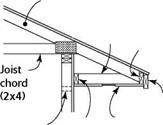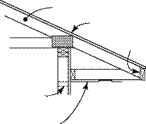CREATING EXTERIOR SOFFITS
In the dry Southwest, open, exposed rafter tails are preferred. But elsewhere—especially in cold, wet locations—soffits are more popular. Eave soffits are usually vented.
There are quite a few ways to frame soffits. The easiest way is to have the truss company extend the joist chord beyond the building line to form a level overhang. This is called a raised-heel truss.
If the trusses do not have a raised heel, you can still build a soffit easily by sheathing the underside of the sloped rafter tails. For a level soffit, nail a long 2x to the building and sheath between it and the gutter board or subfascia. If only a fascia board is used, cut a groove near the bottom edge to support the outer edge of the soffit board. No matter which type of fascia treatment you choose, make sure you install fire-stops between the studs to help prevent a fire in the wall from spreading into the soffit area. Check with your building department to find out which fire-stop details are required.
|
|||
|
|||
|
|
||
|
|||
|
|||
|
|||
|
|||
|
|||
 |
|||
|
|||
|
|||
 |
|||
|
|||
|
|||









Leave a reply